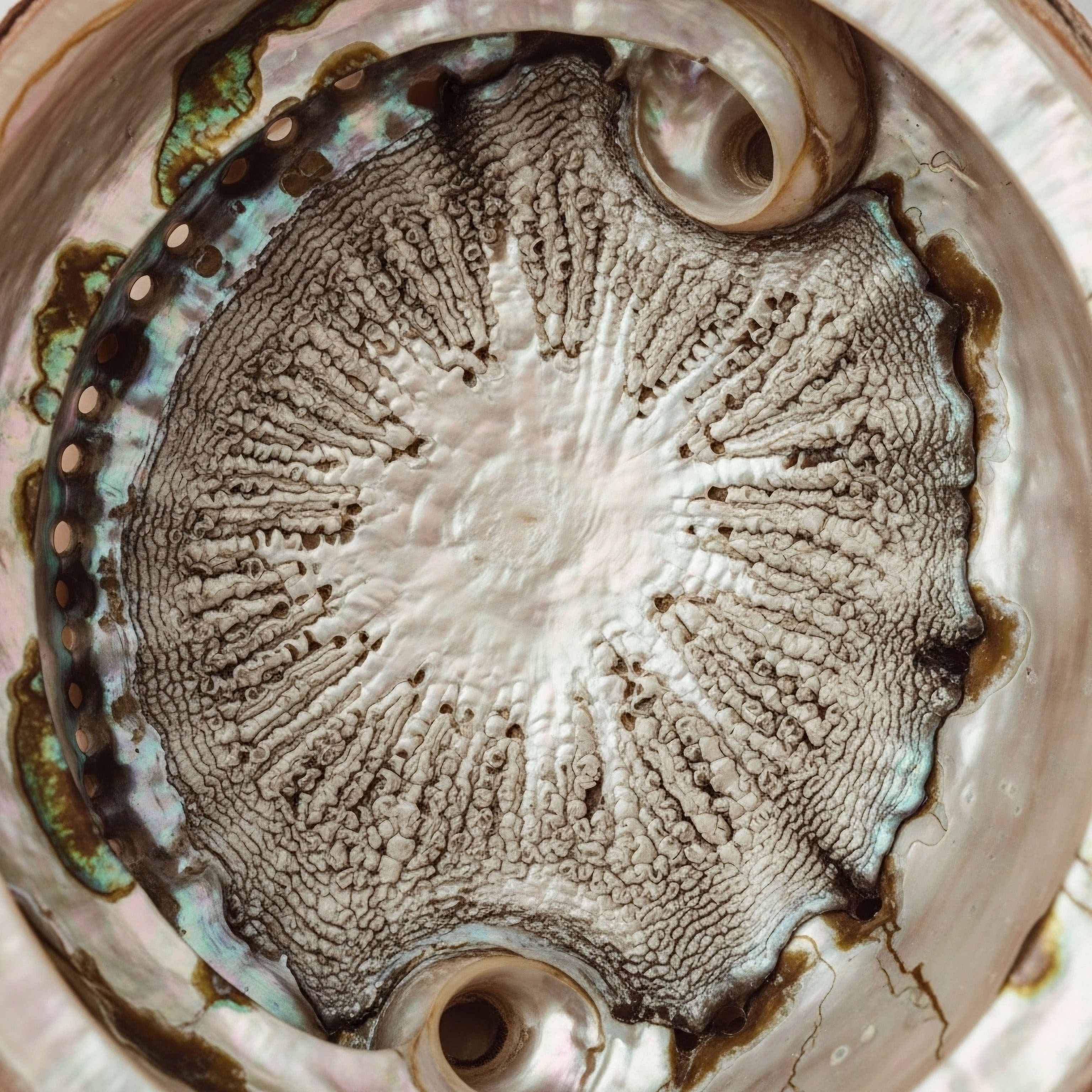

Fundamentals
Perhaps you have felt a subtle shift, a quiet diminishment of the vitality that once defined your days. The energy you once commanded seems less available, your sleep less restorative, and your body’s responses to exercise or dietary changes feel muted.
These are not merely the inevitable consequences of passing years; they are often signals from your internal messaging system, the intricate network of hormones and signaling molecules that orchestrate every aspect of your well-being. Your experience is valid, and it points to a deeper biological conversation occurring within your cells.
Understanding these internal communications is the first step toward reclaiming your full functional capacity. The body operates through a sophisticated symphony of chemical messengers. These messengers dictate everything from your mood and energy levels to your metabolic rate and tissue repair processes. When this delicate balance is disrupted, the symptoms you experience are not isolated incidents; they are manifestations of a system seeking equilibrium.
Within this complex biological landscape, peptides represent a class of signaling molecules that are gaining recognition for their targeted actions. These short chains of amino acids act as precise communicators, instructing cells to perform specific functions. Unlike larger protein structures or broad-acting hormones, peptides often interact with highly specific receptors, initiating cascades of events that can influence various physiological processes.
Their role in the body is akin to a finely tuned instrument within an orchestra, capable of eliciting very particular responses.
Your body’s subtle shifts in vitality often signal deeper imbalances within its intricate hormonal and metabolic communication systems.
The long-term outcomes of peptide therapy are intrinsically tied to their specific biological targets and the broader context of your endocrine and metabolic health. Consider the body’s natural healing mechanisms. When tissue is damaged, a complex series of events unfolds, involving various growth factors and repair signals.
Certain peptides can mimic or enhance these natural signals, potentially accelerating recovery or supporting tissue integrity over time. This targeted approach aims to restore or optimize physiological functions that may have become suboptimal due to aging, stress, or other factors.
A fundamental concept in understanding peptide therapy involves the body’s own regulatory feedback loops. Your endocrine system, for instance, operates much like a sophisticated thermostat. When a particular hormone level drops, the brain sends signals to stimulate its production. Peptides can interact with these feedback loops, either by directly stimulating hormone release or by modulating the sensitivity of target cells.
This interaction is designed to encourage the body to restore its own optimal function, rather than simply replacing a missing substance.

What Are Peptides and Their Biological Role?
Peptides are essentially miniature proteins, composed of two or more amino acids linked by peptide bonds. Their relatively small size allows them to interact with specific cellular receptors, acting as keys that fit into particular locks to initiate biological responses. These molecules are ubiquitous in the body, serving diverse roles as hormones, neurotransmitters, growth factors, and immune modulators.
For instance, insulin, a vital regulator of blood sugar, is a peptide hormone. Many of the body’s natural signaling pathways rely on these precise chemical messages.
The specificity of peptide action is a key characteristic. Unlike pharmaceutical drugs that might have broad effects, peptides often target very particular pathways or cell types. This specificity can lead to more precise physiological responses with potentially fewer systemic side effects.
When considering the long-term outcomes of peptide therapy, this targeted mechanism suggests a potential for sustained, physiological improvements rather than merely symptomatic relief. The goal is to recalibrate the body’s own systems, guiding them back toward a state of optimal function.


Intermediate
Moving beyond the foundational understanding, the practical application of peptide therapy involves specific protocols designed to address particular physiological needs. These protocols are not isolated interventions; they are integrated components within a broader strategy for hormonal optimization and metabolic recalibration. The long-term outcomes of peptide therapy are therefore best understood within the context of these comprehensive approaches, which often complement other forms of endocrine system support.
Consider the realm of Growth Hormone Peptide Therapy, a significant area of interest for active adults and athletes seeking anti-aging benefits, muscle gain, fat loss, and sleep improvement. These peptides function by stimulating the body’s natural production and release of growth hormone (GH) from the pituitary gland. They are not exogenous growth hormone itself, but rather secretagogues that encourage the body to produce its own.

Growth Hormone Peptide Protocols
Several key peptides are utilized in this category, each with distinct mechanisms and potential long-term effects ∞
- Sermorelin ∞ This peptide is a Growth Hormone-Releasing Hormone (GHRH) analog. It stimulates the pituitary gland to release GH in a pulsatile, physiological manner, mimicking the body’s natural rhythm.
Long-term use aims to restore more youthful GH secretion patterns, potentially leading to sustained improvements in body composition, skin elasticity, and sleep quality.
- Ipamorelin / CJC-1295 ∞ Ipamorelin is a selective GH secretagogue that does not significantly affect cortisol or prolactin levels, making it a cleaner option.
CJC-1295 is a GHRH analog with a longer half-life, often combined with Ipamorelin to provide a sustained GH release. The combination aims for consistent elevation of GH, supporting long-term metabolic health and tissue repair.
- Tesamorelin ∞ Primarily known for its role in reducing visceral adipose tissue in HIV-associated lipodystrophy, Tesamorelin is a GHRH analog that has broader applications in metabolic health.
Its long-term use can influence lipid profiles and body fat distribution, contributing to sustained improvements in metabolic markers.
- Hexarelin ∞ A potent GH secretagogue, Hexarelin also has cardioprotective properties. Its long-term effects extend beyond GH release to potential benefits for cardiac function and tissue regeneration.
- MK-677 (Ibutamoren) ∞ While technically a non-peptide GH secretagogue, MK-677 is often grouped with these peptides due to its similar action.
It orally stimulates GH release and IGF-1 levels. Long-term administration aims to support muscle mass, bone density, and sleep architecture.
The long-term outcomes of these therapies are generally observed as a gradual improvement in various physiological markers. Patients often report enhanced recovery from physical exertion, more restful sleep, subtle shifts in body composition (reduced fat, increased lean mass), and improved skin tone. These changes reflect the sustained influence of optimized growth hormone levels on cellular regeneration, protein synthesis, and metabolic regulation.
Peptide therapies, particularly those stimulating growth hormone, aim for sustained physiological improvements by restoring the body’s natural hormonal rhythms.

Targeted Hormone Replacement Therapy Applications
Peptides can also play a supportive role in conjunction with traditional hormone replacement therapy (HRT), particularly in maintaining endogenous hormone production or mitigating side effects.

Testosterone Replacement Therapy Men
For men experiencing symptoms of low testosterone, a standard protocol often involves weekly intramuscular injections of Testosterone Cypionate. To maintain natural testosterone production and fertility, Gonadorelin is frequently included, administered via subcutaneous injections twice weekly.
Gonadorelin acts as a Gonadotropin-Releasing Hormone (GnRH) agonist, stimulating the pituitary to release Luteinizing Hormone (LH) and Follicle-Stimulating Hormone (FSH), which in turn signal the testes to produce testosterone and sperm. Long-term inclusion of Gonadorelin aims to preserve testicular function and fertility, addressing a common concern with exogenous testosterone administration.
Additionally, Anastrozole, an aromatase inhibitor, is often prescribed to block the conversion of testosterone to estrogen, reducing potential side effects like gynecomastia or water retention. Enclomiphene may also be incorporated to specifically support LH and FSH levels, further promoting endogenous testosterone synthesis. The long-term outcome of this comprehensive approach is not merely symptom alleviation but a more balanced endocrine environment, minimizing the typical trade-offs associated with testosterone therapy alone.

Testosterone Replacement Therapy Women
Women experiencing symptoms related to hormonal changes, such as irregular cycles, mood shifts, hot flashes, or diminished libido, can also benefit from targeted hormonal support. Protocols may include low-dose Testosterone Cypionate, typically 10 ∞ 20 units (0.1 ∞ 0.2ml) weekly via subcutaneous injection. This aims to restore testosterone to optimal physiological levels, supporting energy, mood, and sexual function.
Progesterone is prescribed based on menopausal status, playing a crucial role in uterine health and overall hormonal balance. For some, long-acting Pellet Therapy for testosterone may be considered, offering sustained release. When appropriate, Anastrozole can be used in women to manage estrogen levels, particularly in post-menopausal women receiving testosterone. The long-term objective is to restore hormonal equilibrium, leading to sustained improvements in quality of life and symptom resolution.

Post-TRT or Fertility-Stimulating Protocol Men
For men who have discontinued TRT or are trying to conceive, a specific protocol is designed to reactivate the body’s natural testosterone production and spermatogenesis. This includes Gonadorelin to stimulate pituitary function, alongside selective estrogen receptor modulators (SERMs) like Tamoxifen and Clomid. These SERMs block estrogen’s negative feedback on the pituitary, thereby increasing LH and FSH release.
Optionally, Anastrozole may be used to manage estrogen levels during this phase. The long-term outcome is the restoration of the Hypothalamic-Pituitary-Gonadal (HPG) axis, allowing for natural hormone production and fertility.

Other Targeted Peptides
Beyond growth hormone and fertility support, other peptides offer highly specific long-term benefits ∞
- PT-141 (Bremelanotide) ∞ This peptide targets melanocortin receptors in the brain, influencing sexual desire and arousal. Its long-term use can help restore natural sexual function and desire in both men and women, addressing issues that often stem from neurological rather than purely hormonal imbalances.
- Pentadeca Arginate (PDA) ∞ PDA is recognized for its roles in tissue repair, healing, and inflammation modulation.
Long-term application of PDA aims to support chronic tissue regeneration, reduce persistent inflammatory responses, and accelerate recovery from injuries, contributing to sustained musculoskeletal health and reduced pain.
The table below summarizes the primary applications and long-term aims of various peptide therapies and related protocols.
| Peptide/Protocol | Primary Application | Long-Term Outcome Aim |
|---|---|---|
| Sermorelin, Ipamorelin/CJC-1295 | Growth Hormone Optimization | Improved body composition, sleep, recovery, skin elasticity |
| Tesamorelin | Visceral Fat Reduction, Metabolic Health | Sustained metabolic marker improvement, reduced abdominal fat |
| Hexarelin | GH Release, Cardioprotection | Enhanced cardiac function, tissue regeneration, GH support |
| MK-677 | GH Release, Muscle/Bone Support | Increased lean mass, bone density, sleep quality |
| Gonadorelin (with TRT) | Testicular Function Preservation | Maintained endogenous testosterone production, fertility |
| PT-141 | Sexual Health, Libido | Restored sexual desire and arousal |
| Pentadeca Arginate (PDA) | Tissue Repair, Anti-Inflammation | Accelerated healing, reduced chronic inflammation, musculoskeletal health |


Academic
A deeper exploration into the long-term outcomes of peptide therapy necessitates a systems-biology perspective, acknowledging the intricate interplay of various biological axes and metabolic pathways. The human body is an integrated network, where changes in one system inevitably ripple through others. Understanding these interconnections is paramount to appreciating the sustained impact of targeted peptide interventions.
Consider the Hypothalamic-Pituitary-Gonadal (HPG) axis, a prime example of a complex neuroendocrine feedback loop. The hypothalamus releases Gonadotropin-Releasing Hormone (GnRH), which signals the pituitary gland to secrete Luteinizing Hormone (LH) and Follicle-Stimulating Hormone (FSH). These gonadotropins then act on the gonads (testes in men, ovaries in women) to produce sex hormones like testosterone and estrogen. These sex hormones, in turn, exert negative feedback on the hypothalamus and pituitary, regulating their own production.
Peptides like Gonadorelin directly interact with this axis. As a GnRH analog, Gonadorelin stimulates the pituitary, thereby maintaining the downstream signaling to the gonads. In the context of long-term testosterone replacement therapy in men, the exogenous testosterone can suppress the HPG axis, leading to testicular atrophy and impaired spermatogenesis.
The co-administration of Gonadorelin aims to prevent this suppression, preserving testicular size and function over extended periods. Clinical studies have shown that such co-treatment can mitigate the negative impact on spermatogenesis, a significant long-term outcome for men concerned with fertility preservation.
Peptide therapy’s long-term effects stem from its ability to recalibrate complex biological feedback loops, like the HPG axis, promoting sustained physiological balance.

How Do Peptides Influence Metabolic Pathways?
The influence of peptides extends significantly into metabolic regulation. Growth hormone-releasing peptides (GHRPs) and Growth Hormone-Releasing Hormone (GHRH) analogs, such as Sermorelin and Ipamorelin, stimulate the pulsatile release of endogenous growth hormone. Growth hormone itself is a powerful metabolic regulator, influencing glucose metabolism, lipid profiles, and protein synthesis. Long-term optimization of GH levels, achieved through these peptides, can lead to sustained improvements in body composition, including reductions in adipose tissue and increases in lean muscle mass.
The metabolic effects are mediated through Insulin-like Growth Factor 1 (IGF-1), which is primarily produced in the liver in response to GH stimulation. IGF-1 has anabolic effects on muscle and bone, and also influences glucose uptake and fat oxidation.
Sustained, physiological elevation of GH and IGF-1 levels through peptide therapy can contribute to improved insulin sensitivity and a more favorable metabolic profile over time. This is particularly relevant for individuals experiencing age-related metabolic shifts, where declining GH levels contribute to increased central adiposity and insulin resistance.
Consider the long-term implications for bone mineral density. Growth hormone and IGF-1 play critical roles in bone remodeling. Chronic GH deficiency is associated with reduced bone density. By stimulating endogenous GH, peptides can support bone health, potentially mitigating age-related bone loss over many years. This systemic effect underscores the interconnectedness of hormonal systems and their broad impact on overall physiological integrity.

What Are the Neurotransmitter Interactions of Peptides?
Beyond endocrine and metabolic systems, certain peptides interact with neurotransmitter function, influencing mood, cognition, and even sexual health. PT-141, for instance, acts as a melanocortin receptor agonist. These receptors are distributed throughout the central nervous system and play roles in appetite, energy homeostasis, and sexual function.
By modulating specific melanocortin pathways, PT-141 can restore sexual desire and arousal, addressing a complex interplay of neurological and psychological factors that contribute to sexual dysfunction. The long-term impact here is on sustained improvement in quality of life and relational well-being, stemming from a recalibration of central nervous system signaling.
The precise mechanisms by which peptides exert their long-term effects often involve gene expression modulation and cellular signaling cascades. They can influence the synthesis of various proteins, the activity of enzymes, and the proliferation or differentiation of specific cell types. This deep cellular interaction suggests that their benefits are not merely transient but can lead to sustained physiological adaptations.
| Biological Axis/System | Peptide Interaction | Long-Term Physiological Impact |
|---|---|---|
| Hypothalamic-Pituitary-Gonadal (HPG) Axis | Gonadorelin stimulates pituitary LH/FSH release | Preservation of testicular function, fertility in men on TRT; restoration of natural hormone production post-TRT |
| Growth Hormone/IGF-1 Axis | Sermorelin, Ipamorelin, Tesamorelin stimulate GH release | Improved body composition (reduced fat, increased lean mass), enhanced metabolic markers, supported bone density, better sleep architecture |
| Central Nervous System (Melanocortin System) | PT-141 modulates melanocortin receptors | Restored sexual desire and arousal, improved quality of life related to sexual function |
| Tissue Repair & Inflammation | Pentadeca Arginate (PDA) modulates inflammatory pathways | Accelerated healing of injuries, reduced chronic inflammation, sustained musculoskeletal integrity |
The long-term outcomes of peptide therapy are not about creating supraphysiological states but about restoring and maintaining optimal physiological function. This approach aligns with a philosophy of proactive health management, where understanding and supporting the body’s innate regulatory systems leads to sustained vitality and resilience. The scientific literature continues to expand, providing further evidence for the targeted and enduring benefits of these precise biological messengers.

References
- Liu, P. Y. et al. “Gonadotropin-releasing hormone analogues for male contraception.” Human Reproduction Update, vol. 10, no. 3, 2004, pp. 209-222.
- Veldhuis, J. D. et al. “Physiological regulation of the somatotropic axis ∞ from pulsatility to aging.” Growth Hormone & IGF Research, vol. 15, no. 1, 2005, pp. S1-S12.
- Pfaus, J. G. et al. “The neurobiology of sexual desire.” Journal of Sexual Medicine, vol. 7, no. 1, 2010, pp. 101-113.
- Frohman, L. A. and J. T. Stachura. “Growth hormone-releasing hormone ∞ clinical prospects.” Clinical Endocrinology, vol. 18, no. 1, 1983, pp. 19-34.
- Bowers, C. Y. et al. “GHRP-2, a novel synthetic hexapeptide, is a potent stimulator of GH release in man.” Journal of Clinical Endocrinology & Metabolism, vol. 72, no. 6, 1991, pp. 1334-1340.
- Miller, W. R. and A. S. McNeilly. “The role of growth hormone in the regulation of human mammary gland function.” Journal of Mammary Gland Biology and Neoplasia, vol. 1, no. 1, 1996, pp. 107-118.
- Walker, R. F. et al. “Growth hormone-releasing peptides and their therapeutic potential.” Current Pharmaceutical Design, vol. 11, no. 28, 2005, pp. 3629-3642.

Reflection
As you consider the intricate dance of hormones and peptides within your own biological system, perhaps a new perspective on your personal health journey begins to take shape. The knowledge shared here is not merely a collection of facts; it is an invitation to look inward, to listen more closely to the signals your body sends. Understanding these complex biological mechanisms can transform a sense of vague unease into a clear path toward proactive well-being.
Your body possesses an inherent capacity for balance and restoration. The insights gained from exploring peptide therapy and hormonal optimization protocols serve as a starting point, a framework for a more personalized dialogue with your own physiology.
This understanding empowers you to engage with your health not as a passive recipient of care, but as an active participant in your own vitality. The path to reclaiming optimal function is deeply personal, guided by both scientific evidence and your unique lived experience.



